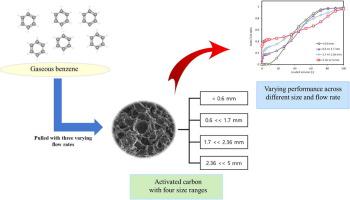Chemical Engineering Journal ( IF 13.3 ) Pub Date : 2021-06-24 , DOI: 10.1016/j.cej.2021.130977 Seung-Ho Ha , Sherif A. Younis , Kumar Vikrant , Jan E. Szulejko , Ki-Hyun Kim

|
To learn more about the competing roles of the key process variables (e.g., particle size vs. space velocity) in the adsorption of volatile organic compounds (VOCs), the breakthrough (BT) behavior of gaseous benzene (at 3 Pa) was investigated using microporous activated carbon (AC) beds built individually with each of four different particle size ranges (< 0.6, 0.6 - 1.7, 1.7 - 2.36, and 2.36 - 5 mm) at three flow rates (300, 500, and 1000 mL·min-1). The effects of each variable on AC performance were evaluated in relation to the occurrence patterns of BT. The key performance metrics (e.g., capacity and partition coefficient) generally increased with decreases in particle size and flow rate, reflecting the critical role of sorbent bed physical properties (e.g., surface area, space velocity, and residence time) in the adsorption process. The smallest particle group (< 0.6 mm) exhibited the highest uptake rate in the initial BT stage in terms of breakthrough volume (BTV: L·g-1) (e.g., BTV5% (5% BTV) = 424 L·g-1). In contrast, the order for 100% BT was reversed to record the highest at the largest particle group (2.36 – 5 mm). The kinetic modeling suggests the dominant role of the pore-diffusion mechanism on the overall adsorption process with enhanced benzene uptake rate onto smaller carbon particle sizes at higher flow rates. Based on this work, we recommend accurate determination of the relative dominance between adsorbent particle size and space velocity to maximize the efficiency of air filtration systems for real-world applications.
中文翻译:

粒径在控制微孔碳床系统中气态苯的动态吸附突破行为中起主导作用的证据
为了更多地了解关键过程变量(例如,粒径与空速)在挥发性有机化合物 (VOC) 的吸附中的竞争作用,使用以下方法研究了气态苯(3 Pa)的突破 (BT) 行为单独构建的微孔活性炭 (AC) 床具有四种不同的粒径范围(< 0.6、0.6 - 1.7、1.7 - 2.36 和 2.36 - 5 mm),三种流速(300、500 和 1000 mL·min - 1)。与 BT 的发生模式相关地评估了每个变量对 AC 性能的影响。关键性能指标(例如,容量和分配系数)通常随着粒径和流速的降低而增加,反映了吸附剂床物理特性(例如,表面积、空速和停留时间)在吸附过程中的关键作用。就突破体积而言,最小的颗粒组(< 0.6 mm)在初始 BT 阶段表现出最高的吸收率(BTV:L·g -1)(例如,BTV 5% (5% BTV) = 424 L·g - 1)。相比之下,100% BT 的顺序相反,在最大颗粒组(2.36 – 5 毫米)处记录最高。动力学模型表明,孔扩散机制在整个吸附过程中起主导作用,在较高流速下,苯吸收率提高到较小的碳颗粒上。基于这项工作,我们建议准确确定吸附剂粒径和空速之间的相对优势,以最大限度地提高空气过滤系统在实际应用中的效率。











































 京公网安备 11010802027423号
京公网安备 11010802027423号